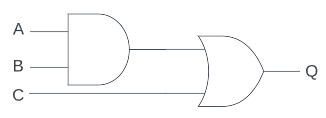Exam style questions
Download a pdf version of the test
Use the space below each question or a pen and paper to write your answer. When complete click the button for the answer and mark scheme.
NOTE: Answers typed into the browser will not be retained if you leave the page or refresh
Questions
 Logic gates
Logic gates
Give the correct name for each of the logic gates in the image above. (4 marks)
Gate a
Gate b
Gate c
Gate d

1 mark per correctly labelled gate
 Logic circuit
Logic circuit
The Boolean expression for the logic circuit above is: (1 mark)
Complete the truth table for the logic circuit above (8 marks)
The Boolean expression is Q=(A.B)+C
| A |
B |
C |
A.B |
Q |
| 0 |
0 |
0 |
0 |
0 |
| 0 |
0 |
1 |
0 |
1 |
| 0 |
1 |
0 |
0 |
0 |
| 0 |
1 |
1 |
0 |
1 |
| 1 |
0 |
0 |
0 |
0 |
| 1 |
0 |
1 |
0 |
1 |
| 1 |
1 |
0 |
1 |
1 |
| 1 |
1 |
1 |
1 |
1 |
1 mark per correct row
From the following list place each item in either the systems software or applications software group.
List: Windows, Disk defragmenter, Presentation Software, Auto-updater, Web browser, Game (2 marks)
System software:
Application software:
System software: Windows,Disk defragmenter,Auto-updater
Applications software: Presentation software,Web browser,Game
1 mark per list allow one extra for 1 mark
Name and describe 3 of the 5 main roles of the operating system. (6 marks)
Processor management - manage time on the processor for the various applications running
Memory management - allocate and free up space in RAM for programs to run
Input output management - manage the receiving of data from input devices and sending of data to output devices
Applications management - allow the user to interact with programs through an API
Security management - manage user access and control access rights using a system of usernames and paswords
1 mark for each correctly identified role up to 3 marks, 1 mark for each correct description
Explain the differences between low level and high level languages and give an example of each. (5 marks)
High level languages are more like english than low level languages.(1) One instruction in a high level language may translate to several low level instructions.(1) High level languages need a compiler or interpreter to
translate them, assembly code needs an assembler and machine code is ready to run.(1) Low level example: binary/machine code or assembly language(1) High level example: Python, C++, Javascript etc.(1)
Explain the similarities and differences between the three types of translators. (3 marks)
All 3 get code ready to be processed by converting to bonary or calling binary instructions.(1) An assembler and a compiler both produce executable machine code but a translator calls machine code subroutines to run the code.(1)
Low level code uses an assembler, high level code uses a compiler or interpreter(1)
 CPU specifications
CPU specifications
Jim likes to play games on his computer. Sometimes he will be researching online while listening to music and having open a couple of documents he is working on. He wants the most powerful computer he can get. He has got it down
to a choice of 3. The specifications for their CPUs are above. Explain how the three factors shown affect CPU performance and explain which to choose and why. (5 marks)
Clock speed measured inGhz is the number of instructions it can process per second with more being better.(1) Cores are effectively seperate processors. A dual core means there are two and a quad core means there are 4.(1)
Cache is a small fast area of storage for regularly used and recently used instructions and data. Having more speeds up processing.(1) Although the first computer has the highest clock speed the others have multiple cores and
in total execute more instructions (4.8GHz).(1) As they can complete the same number of instructions it comes down to cache and so the dual core would be best.(1)
What is meant by the Von Neumann architecture? (1 mark)
Data and instructions are stored together in the same memory.(1)
Explain the role of buses in the CPU. (2 marks)
Buses are wires that connect the components of the CPU(1) and carry signals from one part to another.(1)
Explain the difference between the two types of main memory. (3 marks)
The two types are RAM and ROM.(1) RAM is volatile and ROM is non-volatile.(1) RAM stores currently running programs and their data, ROM stores the boot up instrctions to start the computer.(1)
Explain what secondary storage is and why it is needed. (2 marks)
Secondary storage is our long term storage on PC for files and programs(1) and is needed because RAM is volatile and ROM is very small so without it we coudn't retain files or programs when the power is switched off.(1)
Explain how optical storage works. Include both how data is stored and read. (5 marks)
A strong laser is used to burn holes called pits(1) in a single track that spirals out from the center of the disk.(1) .To read an optical disk a low powered laser is shone onto the surface.(1) If it strikes either a pit or a
land, which is the name for an unburned section, it reflects directly back and is recorded as a 0. If it hits a section going into or out of a pit, it is reflected a different direction and reads as a 1.(1)
Explain the advantages and disadvantages of cloud storage compared to local storage. (4 marks)
Advantages: Access your files from anywhere(1); share data more easily(1); backed up for you(1)
Disadvantages: Need an internet connection to access it(1); concerns about data security(1)
max 4 any combo.
Explain what an embedded system and give an example. (2 marks)
An embedded system is a basic computer system built into another device(1); Any suitable example of an inbuilt single purpose computer e.g. toaster, microwave(1)
<< Previous: Embedded systems Computer systems home GCSE home Next: Types of network >>